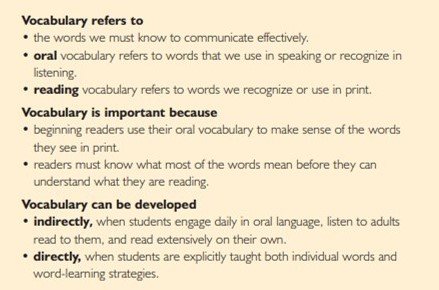WORD STUDY
Word study is exploring reading at the word level, and includes building knowledge of how words work, knowledge of word parts, knowledge of word meanings, and word learning strategies.
Teaching Spelling
———————————————————————————————————————-
According to Bear and colleagues (2020), spelling instruction should start with the alphabetic principle and progress to patterns and word parts common in the English language.
Alphabetic principle -Knowledge that letters make sounds and that in English words are formed left to right
Pattern information - Knowledge that English has predictable patterns of groups of letters that represent sounds. Example patterns include: Consonant/Vowel/Consonant (CVC) pattern to form short vowels (ex. car, cat, rat) or CVCe and CVVC patterns to form long vowels (ex. rate, meal).
Word origins- Knowledge that English consists of words from different languages. Knowledge of the word origin can provide help predict the spelling (ex. ‘ch’ sounds like /ch/ in Anglo-Saxon words like check, /sh/ in French words like niche, and /k/ in Greek words like chaos).
Morphemic awareness- Word origins can also help us predict parts of words, or morphemes. Common morphemes in English are from Greek and Latin roots (ex. pre- in the word prefix means before).
Read this article about how and when to teach spelling in a way that builds students knowledge of words and the English language.
How Words Cast Their Spell.pdf
Vocabulary
———————————————————————————————————————-
Vocabulary knowledge is knowing what words mean and consists of oral vocabulary and reading vocabulary. We might know a word when it is said to us but not recognize it in a book. Or, maybe we learned a word through reading but don't know how it is pronounced. If a reader does not know many of the words in a text, they will struggle to make meaning texts. Words are the building blocks readers need to construct meaning while reading. Some say that as much as 80% of comprehension is related to vocabulary knowledge.
(National Institute for Literacy, 2006)
We learn vocabulary indirectly and directly. Teachers can strategically choose words related to content or books students will encounter and directly teach the words before reading to help aid comprehension. We can also teach word-learning strategies so that students can become independent readers, like using context clues or a dictionary. When we make decisions about which words to directly teach, the tiered vocabulary pyramid is useful.
Tier 1: Common words
These are everyday words that are used in and out of school. Students might be familiar with these words and even might know what they mean. Examples: big, small, house, table, family
Tier 2: High-frequency words
These are academic words used often across content areas in school. These words have high utility and are used in many textbooks. Examples: justify, explain, expand, predict, summarize, maintain
Tier 3: Low-frequency, domain specific
These are technical words unique to a domain or discipline. They are often unfamiliar to students but important for disciplinary learning. Examples: isotope, tectonic plates, carcinogens, mitosis, lithosphere
Teachers can focus energy on teaching the Tier 2 and Tier 3 words students need to know in a unit. Repeated exposure through hearing, seeing, saying, and writing the words helps make the words meaningful.
Make it stand out
Whatever it is, the way you tell your story online can make all the difference.
Teaching Vocabulary
———————————————————————————————————————-
DIALOGIC READ ALOUDS TO TEACH VOCABULARY
Reading aloud with children is a research-based way to build students vocabulary. Making the read aloud dialogic means that the teacher and students engage in dialogue as they read the text together. Students can ask questions about words and ideas. Teachers can model what they are thinking when reading and prompt students to extend their thinking. Here are some books that build word knowledge.
Picture Books for Word Knowledge (Hiebert, 2014)
EXPLICIT TEACHING OF VOCABULARY
Explicitly teaching vocabulary is integrated with content learning and reading contexts. To effectively teach vocabulary, students need multiple opportunities to see and use the word through reading, writing, speaking, listening, and visually representing. Watch this video and read the article below to learn why.
Generative Vocabulary Instruction.pdf
CONNECTION OF VOCABULARY AND COMPREHENSION
Teaching vocabulary is important because there is a connection between comprehension and building vocabulary. Read this article to learn more.
Supporting Emerging Bilingual Students
———————————————————————————————————————-
Check out the Cololrín Colarado website for ideas on ways to engage English language learners in vocabulary activities.
Learn More
———————————————————————————————————————-
We have included resources grouped by age level for you to explore to learn more.
EARLY CHILDHOOD
Check out this article Making Connections to Words to Increase Early Childhood Vocabulary Learning where researchers show how making personal connections to words can help young children build their vocabulary
The Contribution of Play Experiences in Early Literacy: Expanding the Science of Reading
UPPER GRADES
This article Lessons from a Decade of Research on Multifaceted Vocabulary Instruction is packed full of practical guidance and tools for teachers looking to implement effective multifaceted vocabulary instruction.
The articles attached below gives ideas for teaching vocabulary across content areas.
Teaching Vocabulary Across the Curriculum.pdf
Vocabularies of Narrative and Informational Texts




